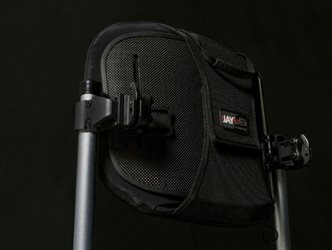Share:
Enhancing Rigidity in Folding Wheelchairs
The Clinical Corner article, Manual Mobility: The Basics, describes the different categories of manual wheelchairs, known generically as transport, standard, folding, rigid, and tilt-in-space. It was noted that the more rigid the wheelchair, the easier it is to propel the chair as rigidity decreases flex in the frame of the chair. The ideal is that all of the energy of propulsion is translated into movement as any frame flex is lost movement. The more rigid the wheelchair, the more efficient the propulsion can be. This is one of the reasons that rigid wheelchairs are selected for individuals. Sometimes, however, an individual requires a folding wheelchair to suit their needs. In this case, it is important to understand how rigidity can be enhanced in a folding frame wheelchair in order to optimize efficient propulsion. (Recall that rolling resistance also effects efficiency of propulsion. See the Clinical Corner article, Rolling Resistance in Manual Wheelchairs, for more on rolling resistance.) This month's Clinical Corner article will look at some of the ways in which rigidity can be enhanced in a folding wheelchair.
Cross-brace Design
The cross-brace on a manual wheelchair allows for the side-to-side folding of the wheelchair when needed for storage or transporting the chair; however, it is typically in the cross-brace where flex can occur during propulsion. Therefore, the design of the cross-brace is an important factor in minimizing flex during propulsion. The shape of the tubing in the cross-brace, the number of "arms", the product material and a locking mechanism will effect rigidity during propulsion.
The photos in the centre and to the left, below, show a 4-armed cross-brace with diamond-shaped tubing. Both the shape of the tubing and the number of arms on the cross-brace, as well as the tight connections, influence strength and rigidity. In addition, the material used in the production of the cross-brace, such as aerospace aluminum, can increase the strength and stiffness of the cross-brace design.
The photo to the right, below, illustrates a pediatric folding frame wheelchair that has a locking mechanism for the cross-brace. The photo shows pulling up on a loop that unlatches the lock below. When unfolding the wheelchair and pushing down on the lock in the centre, there will be an audible "click" when the cross-brace is locked in position. This enables the wheelchair to have a similar performance as a rigid frame wheelchair by minimizing flex in the frame of the wheelchair through the cross-brace.
Seat Saddles
Manual wheelchairs that have a modular frame design use "seat saddles" as the seat rails sit above the side frames of the wheelchair, as shown below. (For more on modular frame designs, see the Clinical Corner article, Manual Wheelchair Prescription: Beginning with the Future in Mind.) There are four seat saddles – two on each side (as shown in the photo to the left, below). The top and bottom of the seat saddle unit are shaped slightly differently, as the photo to the below right shows. This allows for a choice in how the seat saddles are mounted on the wheelchair frame. In one position, the frame is easy to fold and unfold. In another position, the seat rails more firmly lock in place, adding rigidity to the wheelchair; however, it requires more effort to pull the frame into a folding position. A compromise solution is to have one set of seat saddles in one position and the other set in another position (e.g., front versus rear seat saddles) to have some additional rigidity while still allowing ease of folding of the wheelchair.
Fixed Front End
The more moving parts on a wheelchair, the more potential for flex and lost energy in propulsion. For individuals who do not require swing-in or swing-out hangers, a fixed front frame (as shown below in the photo to the left) may be a good option as it is one less moving part on a manual wheelchair, while still having a cross-brace to allow side-to-side folding of the wheelchair. A folding platform, as shown in the photo below to the right, rather than individual foot plates, also enhances rigidity in a folding frame wheelchair as the platform connects the two fixed front hanger tubes together when in a locked position. The platform flips up to one side to allow for transfers.
Stabilizer Bar
A stabilizer bar is sometimes used in manual folding wheelchairs designed for a bariatric population. The stabilizer bar connects the push handles in the rear and provides for another means to offer rigidity to the wheelchair by minimizing the potential for flex in the frame of the wheelchair. This provides for more efficient propulsion for an individual.
Rigid Back Hardware
A past Clinical Corner article addressed Seating Considerations – The Back Rest. A back support can help to achieve numerous seating goals, which may include: positioning, stability, function, skin integrity, and/or increased sitting tolerance. An additional benefit of using a firm back support is the enhanced rigidity that results from attaching the firm back support to the mounting hardware on the back canes of the wheelchair. (See the photograph below.) Because the back canes are connected through the firm back support, greater rigidity can be achieved, rather than using an upholstery or tension-adjustable back support.

Summary
Rigidity in a manual wheelchair allows for greater efficiency of propulsion as the energy of propulsion is directed towards movement, rather than being lost in any flex in the wheelchair. There are numerous factors that can contribute to rigidity in a folding frame wheelchair, including the design of the cross-brace; the choice of seat saddle position in a modular frame wheelchair; the option of a fixed front end, particularly when combined with a flip-up platform; the use of a stabilizer bar; and the prescription of a firm back support.